Parc Ivoloina (eev’-uh-lah-ween) is a recreational and educational zoological park home to lemurs, reptiles, amphibians, and other native Malagasy species near the city of Toamasina in eastern Madagascar. On their own or with a guide, visitors can explore the wildlife exhibits, orchards, an education center, model agricultural station, historic ruins, and nine kilometers of hiking trails. A dugout canoe tour is also available. A sampling can be accomplished as a day trip or visitors can arrange multiple days staying overnight.

Toamasina, meaning "like salt" or "salty", unofficially and in French Tamatave, is the capital of the Atsinanana region on the east coast of Madagascar on the Indian Ocean. The city is the chief seaport of the country, situated 215 km (134 mi) northeast of its capital and biggest city Antananarivo. According to the 2013 official estimate, Toamasina had a population of 274,667. The city is served by Toamasina Airport.

Madagascar, officially the Republic of Madagascar, and previously known as the Malagasy Republic, is an island country in the Indian Ocean, approximately 400 kilometres off the coast of East Africa. The nation comprises the island of Madagascar and numerous smaller peripheral islands. Following the prehistoric breakup of the supercontinent Gondwana, Madagascar split from the Indian subcontinent around 88 million years ago, allowing native plants and animals to evolve in relative isolation. Consequently, Madagascar is a biodiversity hotspot; over 90% of its wildlife is found nowhere else on Earth. The island's diverse ecosystems and unique wildlife are threatened by the encroachment of the rapidly growing human population and other environmental threats.
Beyond the visitor experience, Parc Ivoloina is a regional conservation and education center consisting of a 4 hectare zoological park and a 282 hectare forestry station and offers and Environmental Education Center as well as the Ivoloina Conservation Training Center. The extensive operations on the site are one of the initiatives of the Madagascar Fauna and Flora Group - a non-governmental conservation organization supported by a consortium of zoos, aquariums, botanical gardens, universities, and other related organizations.
Wildlife
Parc Ivoloina is home to twelve different species of lemurs including five species of free-ranging lemurs. Of note are the critically endangered black and white ruffed lemur, the greater bamboo lemur, and the blue-eyed black lemur. The site also cares for three species of nocturnal lemur, including the infamous aye-aye. Visitors can also find radiated tortoises, boas, tomato frogs, panther chameleons, and more
Birders will find malachite kingfishers, white-faced whistling ducks, and many other species around the park's Lake Fulgence.
Note: While some animals were born in the forest, most of the animals at Parc Ivoloina were donated, exchanged with other zoos, or seized by the Malagasy government from illegal operations. All of the animals at Parc Ivoloina were obtained legally.

The aye-aye is a long-fingered lemur, a strepsirrhine primate native to Madagascar that combines rodent-like teeth that perpetually grow and a special thin middle finger.

Lemurs are mammalian animals of the order primates, divided into 8 families and consisting of 15 genera and around 100 existing species. They are native only to the island of Madagascar. Most existing lemurs are small, have a pointed snout, large eyes, and a long tail. They chiefly live in trees (arboreal), and are active at night (nocturnal).
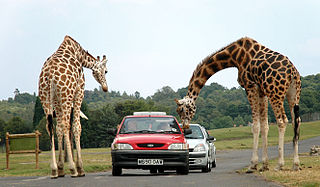
West Midland Safari and Leisure Park is a safari park located in Bewdley in Worcestershire, England. It was opened under the name of West Midland Safari Park in spring 1973.

The golden bamboo lemur, bokombolomena in Malagasy, is a medium-sized bamboo lemur endemic to south-eastern Madagascar.
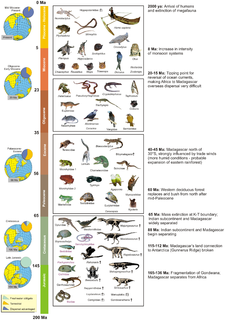
The fauna of Madagascar is a part of the wildlife of Madagascar.

Masoala National Park, in northeast Madagascar, is the largest of the island's protected areas. Most of the park is situated in Sava Region and a part in Analanjirofo. Created in 1997, the park protects 2,300 square kilometres of rainforest and 100 square kilometres of marine parks. The Masoala peninsula is exceptionally diverse due to its huge size, and variety of habitats. Altogether, the park protects tropical rainforest, coastal forest, flooded forest, marsh, and mangrove. Three marine parks protect coral reefs and a dazzling array of marine life.

The Madagascar dry deciduous forests represent a tropical dry forest ecoregion situated in the western and northern part of Madagascar. The area has high numbers of endemic plant and animal species but has suffered large-scale clearance for agriculture. They are among the world's richest and most distinctive dry forests and included in the Global 200 ecoregions by the World Wide Fund. The area is also home to distinctive limestone karst formations known as tsingy, including the World Heritage Site of Bemaraha.

The Madagascar Fauna and Flora Group or MFG is an international consortium of zoos and other conservation agencies which pool resources to help conserve animal species in Madagascar, through captive breeding programs, field research programs, training programs for rangers and wardens, and acquisition and protection of native habitat in Madagascar. It is a non-governmental organization working in conjunction with the
Ministry of Water, Forests, and the Environment, Government of Madagascar. It is the organization behind the Save the Lemur campaign and is headquartered at the Saint Louis Zoo.

Anjajavy Forest is an element of the Madagascar dry deciduous forests situated on the Indian Ocean of northwest Madagascar. The Anjajavy Forest surrounds the village of Anjajavy and provides a habitat for many rare and endangered species. It covers roughly fifty square kilometres, and occupies a continuous portion of the peninsula upon which Anjajavy village lies. The peninsula is bounded by Majajamba Bay to the south and Narinda Bay to the north. Anjajavy Forest has much in common with other dry deciduous forests rising out of the tsingy limestone formations of western Madagascar. It is due to the presence of expansive tsingy outcrops as well as the remoteness of this part of Madagascar from the population center of the country at Antananarivo that the forest here has been less disturbed than many other forests in the country. For example, the central highland plateau, readily accessible from the population center, has been decimated by decades of slash-and-burn farming by indigenous peoples, leading to massive desertification and erosion. The incidence of species endemism in the western dry forests is very high, including ten of the fourteen known lemur genera, five of the eight tenrec genera and 16 of the 17 Chiroptera genera of Madagascar represented. There are a variety of mammals, birds, reptiles and arthropods present within the Anjajavy Forest.

Andasibe-Mantadia National Park is a 155 square kilometre protected area, located about 150 km east of Antananarivo, consisting principally of primary growth forest in Alaotra-Mangoro Region in eastern Madagascar. The park's elevation ranges from 800–1260 meters, with a humid climate. Average annual precipitation is 1700 mm, with rainfall on 210 days of each year. This rainforest is habitat to a vast species biodiversity, including many endemic rare species and endangered species, including 11 lemur species. The park's two component parts are Mantadia National Park and Analamazoatra Reserve, which is best known for its population of Madagascar's largest lemur, the indri.

The Masoala fork-marked lemur, also known as the eastern fork-marked lemur or Masoala fork-crowned lemur, is a species of lemur found in the coastal forests of northeastern Madagascar. It is a small nocturnal animal with large eyes, greyish fur and a long tail.
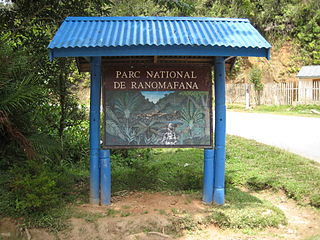
Ranomafana National Park is in the southeastern part of Madagascar in Haute Matsiatra and Vatovavy-Fitovinany. With more than 41,600 hectares of tropical rainforest, it is home to several rare species of flora and fauna including the golden bamboo lemur, the greater bamboo lemur, black and white ruffed lemur and Milne-Edwards sifaka, and over 130 species of frogs. Pitta like ground rollers, blue vangas, short-legged ground rollers and brown mesites can be seen. The park was established in 1991 with the purpose of conserving the unique biodiversity of the local ecosystem and reducing the human pressures on the protected area. It is part of the World Heritage Site Rainforests of the Atsinanana. Adjacent to the park is the Centre ValBio research station, established in 2003 and managed by Stony Brook University with a focus on biodiversity research, community health and education, environmental arts and reforestation.

The composition of Madagascar's wildlife reflects the fact that the island has been isolated for about 88 million years. The prehistoric breakup of the supercontinent Gondwana separated the Madagascar-Antarctica-India landmass from the Africa-South America landmass around 135 million years ago. Madagascar later split from India about 88 million years ago, allowing plants and animals on the island to evolve in relative isolation.
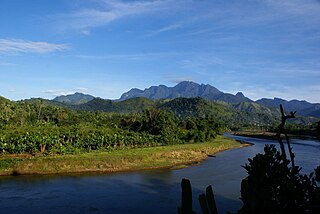
Marojejy National Park is a national park in the Sava Region of northeastern Madagascar. It covers 55,500 ha (214 sq mi) and is centered on the Marojejy Massif, a mountain chain that rises to an elevation of 2,132 m (6,995 ft). Access to the area around the massif was restricted to research scientists when the site was set aside as a strict nature reserve in 1952. In 1998, it was opened to the public when it was converted into a national park. It became part of the World Heritage Site known as the Rainforests of the Atsinanana in 2007. Despite its rugged terrain, poaching and selective logging are still persistent problems, particularly since the start of the 2009 political crisis in Madagascar. Mining, slash-and-burn agriculture, and wood collection also pose threats to the park and its wildlife.

Tsimanampetsotsa National Park also spelt Tsimanampetsotse, and known as Tsimanampetsotsa Nature Reserve is a 432 km2 national park on the south-west coast of Madagascar in the region Atsimo-Andrefana. The park is 90 kilometres (56 mi) south of Toliara and 950 kilometres (590 mi) south of the capital, Antananarivo. Route Nationales (RN) 10 to Faux Cap passes the park and the nearest airport is at Toliara.
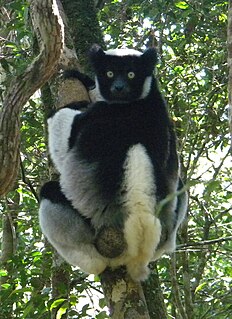
Zahamena National Park is a national park of Madagascar. Established in 1997, it covers an area of 423 square kilometres (163.32 sq mi) out of a total protected area of 643 square kilometres (248.26 sq mi). It is part of a UNESCO World Heritage Site, Rainforests of the Atsinanana, inscribed in 2007 and consisting of 13 specific areas located within eight national parks in the eastern part of Madagascar. In 2001, Bird Life International assessed avifauna of 112 species of which 67 species are exclusively endemic to Madagascar.

Ambatovaky Reserve is a tropical rainforest and wildlife reserve in the north-east of Madagascar. It is designated by Bird Life International as an Important Bird Area for the large number of endemic species of birds.

Mangerivola Special Reserve is a wildlife reserve in the east of Madagascar. It was established in 1958 and is a hotspot for bird-watchers due to the one hundred species found there, including 63 endemics and many local endemics. There are also seven species of lemur and rare chameleons such as the Lance-nosed chameleon which is registered as endangered on the IUCN Red List of Threatened Species.

Lemurs of Madagascar is a 2010 reference work and field guide for the lemurs of Madagascar, giving descriptions and biogeographic data for the known species. The primary contributor is Russell Mittermeier, president of Conservation International, and the cover art and illustrations were drawn by Stephen D. Nash. Currently in its third edition, the book provides details about all known lemur species, general information about lemurs and their history, and also helps travelers identify species they may encounter. Four related pocket field guides have also been released, containing color illustrations of each species, miniature range maps, and species checklists.



















